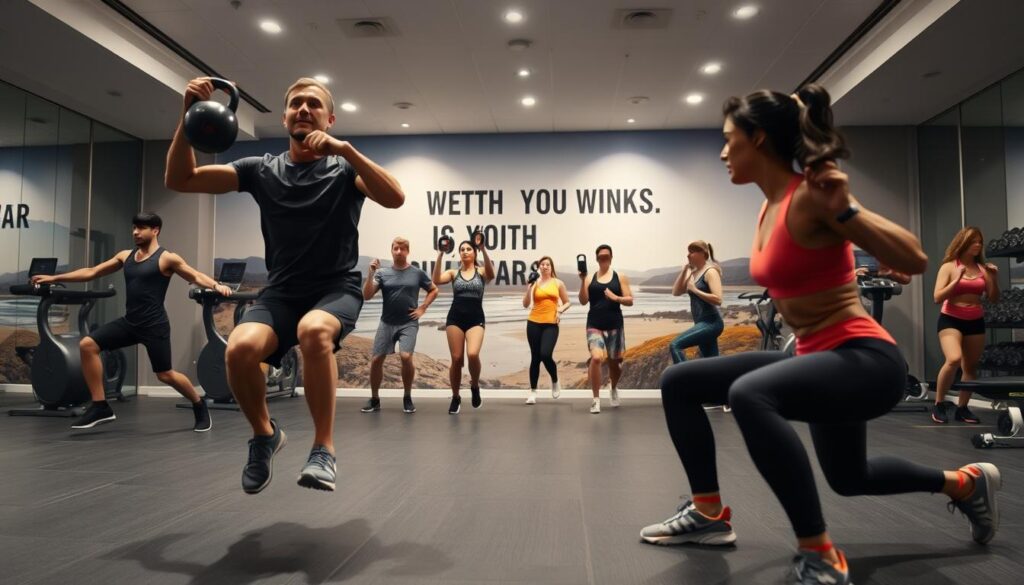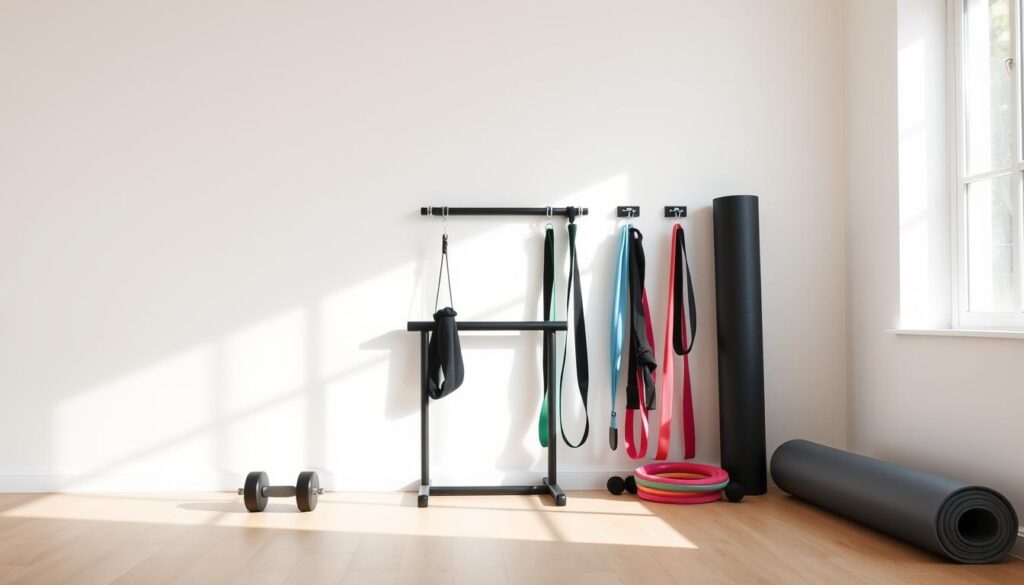Achieving sustainable weight loss is a journey that requires patience, dedication, and a well-planned approach. Many individuals fall into the trap of quick fixes, only to find that the weight returns, leaving them back at square one.
Creating effective workout routines is crucial for long-term success. It’s not just about losing weight; it’s about building a healthier body that can maintain the loss over time. This involves a combination of proper training, consistency, and progressive overload to build muscle and boost fitness.
This guide will help you develop a personalized approach to fitness that leads to lasting results. By understanding the science behind weight loss and creating a tailored plan, you’ll be equipped to avoid common pitfalls that lead to weight loss plateaus.
Key Takeaways
- Understand the importance of sustainable weight loss methods.
- Learn how to create effective workout routines for long-term results.
- Discover the role of proper training and progressive overload in weight loss.
- Develop a personalized fitness plan tailored to your needs.
- Avoid common pitfalls that lead to weight loss plateaus.
Understanding Sustainable Weight Loss
Embracing a sustainable approach to weight loss means moving beyond fad diets and temporary exercise regimes. It’s about creating a lifestyle that fosters long-term health and wellness.

The Difference Between Quick Fixes and Sustainable Methods
Quick-fix approaches to weight loss, such as crash diets and extreme exercise routines, may offer temporary results but often lead to metabolic adaptations that make long-term weight maintenance difficult. In contrast, sustainable weight loss methods focus on gradual, consistent changes that promote a healthy metabolism. Research has shown that losing weight at a rate of 1-2 pounds per week is more likely to be maintained over time.
Sustainable methods prioritize lifestyle changes over temporary restrictions, helping individuals develop healthy habits that can be maintained in the long term. This approach not only supports weight loss but also enhances overall fitness and well-being.
Why Workout Routines Are Essential for Long-Term Results
A well-designed workout routine is crucial for creating the metabolic foundation necessary for long-term fat loss. By incorporating a mix of cardiovascular exercise and strength training, individuals can preserve muscle mass while losing weight, which is vital for maintaining metabolic rate. Consistent workout routines also create positive feedback loops that reinforce healthy behaviors, making it easier to stick to a weight loss plan.
Moreover, a sustainable workout routine helps in building muscle, which further supports the body’s metabolic health. As highlighted in the data, even a short initial period of training can set the stage for long-term muscle gains and overall fitness.
Setting Realistic Weight Loss Goals
Embarking on a weight loss journey requires setting practical and sustainable goals. To achieve successful weight loss, it’s crucial to have a clear understanding of your starting point and where you want to be.
Determining Your Starting Point
Establishing a clear baseline is vital. This involves taking measurements, progress photos, and fitness assessments to understand your current fitness level and identify any limiting factors that might affect your workout selection. By evaluating your starting point, you can create a more effective weight loss plan tailored to your needs.
Creating Achievable Short-Term Milestones
To make your weight loss journey manageable, it’s essential to break down your long-term objectives into achievable short-term milestones. Setting SMART goals (Specific, Measurable, Achievable, Relevant, Time-bound) helps you stay focused and motivated. Celebrating small victories along the way can significantly boost your morale and encourage you to continue.
Establishing Long-Term Objectives
While short-term milestones are important, it’s equally crucial to have long-term objectives in mind. These objectives should focus on sustainable behaviors such as workout consistency and nutrition habits rather than just the number on the scale. By focusing on these behaviors, you can achieve a healthier body and maintain your weight loss over time.

By setting realistic weight loss goals and focusing on both short-term milestones and long-term objectives, you can create a sustainable weight loss plan that suits your fitness level and lifestyle. Adjusting your goals based on progress and changing circumstances is also vital to ensure continued success on your weight loss journey.
The Science Behind Workout Routines for Weight Loss
To achieve sustainable weight loss, it’s essential to comprehend the scientific principles guiding workout routines. Exercise is a critical component of any weight loss program, and understanding how different types of workouts affect the body can help individuals make informed decisions about their fitness regimen.
How Exercise Affects Your Metabolism
Exercise influences metabolism through various mechanisms, one of which is Excess Post-exercise Oxygen Consumption (EPOC). EPOC refers to the increased oxygen consumption by the body after exercise, which can lead to an elevated metabolic rate for an extended period. Different types of workouts, such as high-intensity interval training (HIIT) and strength training, can significantly impact EPOC, thereby affecting metabolism. Strength training, in particular, plays a crucial role by building muscle tissue, which further boosts basal metabolic rate.

The Role of Muscle in Fat Loss
Muscle tissue is metabolically active, meaning it consumes more energy at rest compared to fat tissue. As a result, increasing muscle mass through strength training can enhance basal metabolic rate, helping the body burn more calories. Additionally, muscle tissue improves insulin sensitivity, reducing the risk of developing type 2 diabetes and metabolic syndrome. Preserving muscle mass during a caloric deficit is crucial, as it ensures that weight loss comes primarily from fat stores.
Balancing Cardio and Strength Training
A well-rounded workout routine should balance cardio and strength training. While cardio exercises are effective for burning calories during the activity, strength training provides long-term metabolic benefits by increasing muscle mass. Research supports the combination of both for optimal fat loss. For instance, a workout routine that includes both HIIT for cardio and resistance exercises for strength can maximize calorie expenditure and enhance metabolic adaptations. The key is to find a balance that suits individual goals and preferences, ensuring long-term adherence to the workout regimen.
By understanding the science behind different exercise modalities and their impact on metabolism, muscle, and fat loss, individuals can design more effective workout routines tailored to their needs. This knowledge empowers people to make informed decisions, maximizing their chances of achieving sustainable weight loss.
Choosing the Right Workout Split for Your Lifestyle
Your workout split can make or break your fitness goals, depending on how well it aligns with your schedule and preferences. A workout split refers to how you organize your training throughout the week, dividing your workouts to target different muscle groups or movement patterns. This organization is crucial for ensuring you get the most out of your workouts without overtraining.

Full-Body Workout Plans (3x Per Week)
Full-body workout plans involve training all major muscle groups in a single session, typically done three times a week. This approach is excellent for beginners or those with limited time, as it ensures a balanced workout. Full-body workouts can be efficient and effective, promoting overall muscle growth and strength.
Upper/Lower Body Splits
Upper/lower body splits involve dividing your workouts into two categories: upper body exercises one day and lower body exercises another. This split allows for more variety in your workouts while still maintaining adequate recovery time. It’s a great option for those who want to focus on specific muscle groups without overdoing it.
Push/Pull/Legs Routines
The push/pull/legs (PPL) routine is a popular split that organizes workouts based on movement patterns. It involves dedicating one day to pushing exercises (like bench press), one day to pulling exercises (like rows), and one day to leg exercises. This approach ensures a balanced development of strength and muscle across different muscle groups.
Matching Your Split to Your Schedule and Goals
When choosing a workout split, it’s essential to consider your available training days, recovery capacity, and personal preferences. For instance, if you have a busy schedule, a 3-day split might be more suitable. On the other hand, if you’re looking for more variety and have more time to dedicate, an upper/lower or PPL split could be more beneficial. Ultimately, the best workout split is one that you can stick to consistently and that aligns with your fitness goals.
- Consider your schedule and recovery needs when choosing a workout split.
- Full-body workouts are great for beginners or those short on time.
- Upper/lower and PPL splits offer more variety and can be tailored to specific goals.
- The key to a successful workout split is consistency and alignment with your fitness objectives.
Essential Workout Routines for Sustainable Fat Loss

When it comes to losing fat and keeping it off, the right workout routine can make all the difference. A well-structured workout plan not only helps in burning calories but also in building muscle mass, which further aids in fat loss.
Compound Movements for Maximum Calorie Burn
Compound movements such as squats, deadlifts, and presses are crucial for maximizing calorie expenditure during a workout. These multi-joint exercises recruit more muscle fibers, creating a greater metabolic demand and thus, burning more calories.
Exercises like squats and deadlifts work multiple muscle groups simultaneously, making them highly effective for fat loss. Incorporating these exercises into your workout routine can significantly enhance your fat loss journey.
Targeted Exercises for Problem Areas
While compound movements are essential for overall fat loss, targeted exercises can help shape specific body parts. It’s essential to understand that “spot reduction” is a myth; however, certain exercises can help tone muscles in problem areas.
For example, exercises like lunges can target the legs, while lateral raises can help tone the shoulders. Incorporating these exercises into your routine can help achieve a more balanced physique.
Sample Workout Routine for Beginners
For those new to working out, starting with a simple yet effective workout routine is crucial. A beginner’s routine should include a mix of compound movements and isolation exercises to ensure overall muscle development and fat loss.
A sample routine could include:
– Squats: 3 sets of 8-12 reps
– Push-ups: 3 sets of 8-12 reps
– Lunges: 3 sets of 8-12 reps per leg
– Dumbbell rows: 3 sets of 8-12 reps
– Planks: 3 sets of 30-60 seconds
Remember, the key to a successful workout routine is consistency and progressive overload. Gradually increasing the intensity of your workouts will help in achieving sustainable fat loss.
Progressive Overload: The Key to Continued Results
The key to sustained weight loss lies in applying the principle of progressive overload in your workout routine. Progressive overload refers to the gradual increase in weight, resistance, or reps over time to continue challenging your muscles and promoting growth.
Understanding Progressive Overload Principles
When you start a new training program, your body adapts quickly to the new demands. However, as time passes, your muscles adapt to the exercise stimuli, and progress slows down. To avoid plateaus, it’s essential to increase the intensity of your workouts by adding more weight, doing more reps, or decreasing rest periods between sets.
Methods to Increase Workout Intensity Over Time
There are several ways to implement progressive overload in your workout routine. You can increase the weight you’re lifting, add more reps or sets, or decrease rest periods between exercises. For example, if you’re doing three sets of 10 reps of a particular exercise, you can progress by adding more weight or increasing the number of sets.

Tracking Your Progress Effectively
To ensure consistent progress, it’s crucial to track your workouts. You can use a workout journal, a mobile app, or a spreadsheet to record your exercises, sets, reps, and weight. Tracking your progress helps you identify areas where you need to increase the intensity and make informed decisions about your training program.
By applying the principle of progressive overload and tracking your progress, you can continue to challenge your muscles and achieve sustained weight loss results.
Designing Your 4-Week Beginner Weight Loss Program
For beginners, a 4-week weight loss program provides a clear roadmap to achieving their goals. This structured approach helps in establishing a consistent workout routine and ensures progressive overload, which is crucial for sustainable weight loss.
The program is divided into four weeks, each with a specific focus to keep the workouts engaging and challenging. It begins with a full-body training split, where all major muscle groups are trained in each session.
Week 1: Full-Body Foundation
In the first week, you’ll start with a full-body training split, training three days a week. This involves performing one exercise per major muscle group in each session, with a day of rest in between. For example, you can train on Monday, Wednesday, and Friday. This approach helps in building foundational strength and establishing proper form.

Week 2: Introducing Split Training
In Week 2, you’ll transition to a two-day split routine, focusing on upper body and lower body. This allows for more exercise variety and a slight increase in volume. You’ll perform two exercises per muscle group, with three sets of 8-12 reps.
Week 3: Increasing Volume and Intensity
By Week 3, you’ll move to a three-day split: push, pull, and legs. This routine enables more targeted training and further increases the volume and intensity. You’ll perform three to four sets of 8-12 reps for each exercise.
Week 4: Advanced Techniques and Progression
In the final week, you’ll adopt a four-day split, returning to a full-body routine but with more advanced techniques. This includes increasing the weight, reps, or sets based on your progress. The goal is to challenge yourself while maintaining proper form.
Throughout the 4-week program, it’s essential to listen to your body and adjust the intensity and volume based on your recovery capacity and progress. This program serves as a foundation for continued training, and with consistent effort, you’ll be on your way to achieving your weight loss goals.
Intermediate Weight Loss Workout Plans
Once you’ve established a foundation with beginner workouts, it’s time to step up your training with intermediate weight loss plans. At this level, you’re expected to have a good understanding of proper form and a baseline level of fitness. Intermediate workout plans are designed to challenge your body in new ways, promoting continued weight loss and overall fitness.

3-Day Split Options for Busy Individuals
For those with busy schedules, a 3-day split can be an effective way to continue making progress in your weight loss journey. This can involve dividing your workouts into upper body, lower body, and total body or push, pull, and legs. For example, you could do a push day (chest, shoulders, triceps), a pull day (back, biceps), and a legs day. This ensures that you’re targeting all major muscle groups while allowing for adequate recovery time.
A sample 3-day split could look like this:
- Day 1: Push – Chest press, shoulder press, tricep dips
- Day 2: Pull – Pull-ups, rows, bicep curls
- Day 3: Legs – Squats, lunges, deadlifts
4-Day Split for Accelerated Results
For those who can commit more time, a 4-day split allows for even greater focus on specific muscle groups, potentially leading to accelerated results. A common 4-day split involves pairing chest with triceps, back with biceps, and quads with hamstrings, and then dedicating one day to shoulders and abs or other smaller muscle groups. This approach enables you to train with higher volume and intensity, which can be beneficial for weight loss.
For instance:
- Day 1: Chest and triceps
- Day 2: Back and biceps
- Day 3: Legs (quads and hamstrings)
- Day 4: Shoulders and abs
When and How to Transition from Beginner to Intermediate
Transitioning from a beginner to an intermediate workout plan should be based on your individual progress and comfort level with your current routine. Signs that you’re ready to move to an intermediate level include being able to complete your workouts with ease, having increased strength, and feeling ready for a new challenge. It’s essential to make this transition gradually to avoid overtraining or injury. Start by increasing the intensity or volume of your workouts, and then progress to more complex exercises or different split routines.
As you move to intermediate training, you’ll also incorporate more exercise variety and advanced techniques, such as supersets or periodization, to keep your workouts engaging and challenging. Adjusting your recovery strategies, such as ensuring adequate sleep and nutrition, is also crucial as you increase your training intensity.
Advanced Training Techniques for Plateau Busting
Weight loss plateaus are inevitable, but with the right training strategies, you can overcome them and achieve your goals. As you progress in your weight loss journey, your body adapts to the demands you place on it, making it harder to continue losing weight. This is where advanced training techniques come into play.

High-Intensity Interval Training (HIIT) Integration
One effective method to break through a plateau is by incorporating HIIT into your workout routine. HIIT involves short bursts of high-intensity exercise followed by brief periods of rest. This type of training not only increases calorie expenditure during the workout but also boosts your metabolic rate for hours after, a phenomenon known as excess post-exercise oxygen consumption (EPOC). For example, a HIIT protocol might involve 30 seconds of sprinting followed by 30 seconds of rest, repeated for 15-20 minutes.
Supersets and Circuit Training
Another strategy is to use supersets and circuit training to increase the density and efficiency of your workouts. Supersets involve performing two exercises back-to-back without rest, typically targeting opposing muscle groups or non-competing movements. Circuit training takes this a step further by creating a series of exercises performed in succession with minimal rest between them. Both methods significantly increase the intensity of your workouts, helping to break through plateaus.
Periodization for Long-Term Progress
Periodization is a training approach that involves planned variation in your workout routine to avoid plateaus and ensure long-term progress. By alternating between periods of high intensity and lower intensity, or by changing the focus of your workouts (e.g., from strength training to endurance), you can keep your body guessing and continue making gains. Different periodization models, such as linear, undulating, and block periodization, offer varied approaches to structuring your training program.
By incorporating these advanced training techniques into your workout routine, you can overcome weight loss plateaus and continue making progress toward your goals. It’s essential to strategically implement these methods based on your progress and fitness level to avoid overtraining.
Recovery Strategies for Optimal Results
A good recovery plan is just as important as the workout itself for long-term results. Recovery is a critical component of any successful weight loss journey, allowing your body to repair and rebuild muscle tissue.
The Importance of Rest Days
Rest days are essential for preventing overtraining syndrome and allowing your muscles to recover. It’s recommended to have at least one day of rest between each workout. For example, training on Monday, Wednesday, and Friday, with Saturday and Sunday as rest days, is a good approach. This allows your muscle to repair and grow, making your workout routine more effective.
Proper rest days also help prevent burnout and reduce the risk of injury. By incorporating rest days into your routine, you can maintain a consistent workout schedule and achieve your weight loss goals.
Sleep Quality and Weight Loss Connection
Sleep quality has a significant impact on weight loss. During sleep, your body regulates hormones that control hunger and fullness, such as leptin and ghrelin. Poor sleep quality can disrupt these hormones, leading to increased cravings and weight gain. Additionally, sleep deprivation can raise cortisol levels, further contributing to weight gain.
To improve sleep quality, establish a consistent sleep schedule, avoid caffeine and electronics before bedtime, and create a relaxing bedtime routine. By prioritizing sleep, you can support your weight loss efforts and overall health.
Active Recovery Techniques
Active recovery techniques can help promote blood flow and aid in the recovery process. Examples of active recovery include light cardio, mobility work, yoga, and swimming. These activities can be done on rest days or after a workout to help your body recover.
By incorporating active recovery techniques into your routine, you can reduce muscle soreness and improve overall recovery. This can help you stay on track with your workout routine and achieve your weight loss goals.
Nutrition Fundamentals to Support Your Workout Routine
Achieving sustainable weight loss is not just about regular workout routines; it’s also heavily influenced by your nutritional habits. The synergy between a consistent training regimen and appropriate nutritional strategies is key to achieving your weight loss goals. Proper nutrition supports your workout by fueling your body and aiding in recovery, thereby enhancing overall performance.
Protein Requirements for Muscle Preservation
During a caloric deficit, your body requires more protein to maintain muscle mass. Consuming adequate protein helps preserve muscle, ensuring that the weight lost is primarily fat. The recommended protein intake varies based on body weight and activity level, but generally falls between 1.6 to 2.2 grams of protein per kilogram of body weight per day.
Timing Your Meals Around Workouts
The timing of your meals in relation to your workout can significantly impact your energy levels and recovery. Consuming a balanced meal with carbohydrates and protein 1-3 hours before your workout can enhance performance. Post-workout nutrition, focusing on protein and carbohydrates, aids in recovery and muscle repair.
Hydration Strategies for Enhanced Performance
Hydration plays a critical role in workout performance and metabolic function. It’s essential to hydrate before, during, and after your workout. Aim to drink at least 17-20 ounces of water 2-3 hours before exercise, and continue to hydrate in small amounts during your workout. Monitoring your urine color can help determine your hydration status, with pale yellow indicating proper hydration.
Home vs. Gym Workouts: Equipment Considerations

When deciding between home and gym workouts, equipment considerations play a crucial role in determining the effectiveness of your weight loss journey. Both options have their advantages and limitations, which are discussed below.
Minimal Equipment Options for Home Training
For effective home workouts, minimal equipment is required. Dumbbells are a versatile and essential piece of equipment. You can opt for fixed-weight dumbbells, which can be found second-hand at a discount, or adjustable dumbbells like the Bowflex SelectTech Adjustable Weights, which offer the convenience of multiple weights in one.
The advantages of adjustable dumbbells include space-saving, cost-effectiveness, and the ability to quickly change weights for supersets. Other essential equipment includes resistance bands and an adjustable bench, which can enhance the variety of exercises you can perform at home.
Making the Most of Gym Facilities
Gym facilities offer a wide range of equipment that may not be feasible to have at home, such as heavy machinery for leg press, chest press, and lat pulldowns. To effectively utilize gym facilities, it’s essential to familiarize yourself with the available equipment and plan your workouts accordingly.
In crowded gym environments, strategies such as supersets and circuit training can help you maintain an intense workout while minimizing downtime between exercises.
Bodyweight Alternatives for Common Exercises
Not all exercises require equipment. Bodyweight exercises like push-ups, squats, and lunges are effective alternatives that can be done anywhere. For those who prefer or need to work out at home without equipment, bodyweight exercises can be a great starting point or addition to their routine.
To progress bodyweight exercises, you can modify them to increase difficulty, such as diamond push-ups or single-leg squats, ensuring continued muscle challenge over time.
Adapting Your Routine for Long-Term Sustainability
Long-term adherence to a workout routine demands flexibility and a willingness to make adjustments as needed. As you progress in your fitness journey, it’s crucial to adapt your exercise plan to avoid plateaus and maintain motivation.
Adjusting Workouts as You Progress
As you get stronger and more fit, your workout needs to change to continue challenging your muscles. This can involve increasing the weight, reps, or sets over time. Progressive overload is a key principle here, ensuring that you’re always pushing your limits.
To make sure you’re on the right track, regularly assess your progress. This could be through tracking your workouts, monitoring your weight loss, or measuring your overall fitness improvements.
Maintaining Motivation Through Variety
Variety is essential in preventing both physical and psychological plateaus. Introducing new workouts or training methods can keep your routine fresh and exciting. This could mean trying new exercises, joining a different fitness class, or even working out in a new environment.
According to fitness expert,
“The key to maintaining motivation is to keep the body guessing and to avoid routine. This can be achieved by incorporating a variety of exercises and training methods into your workout plan.”
Balancing Intensity and Enjoyment
Finding a balance between intensity and enjoyment is crucial for long-term sustainability. While it’s important to challenge yourself, it’s equally important to enjoy the process. Incorporating activities you genuinely enjoy into your routine can enhance adherence and make the journey more fulfilling.
By understanding the importance of adaptability and variety in your workout routine, you can create a sustainable fitness plan that supports your long-term goals. This involves being mindful of your progress, maintaining motivation, and ensuring that your workouts remain enjoyable and challenging.
Common Mistakes to Avoid in Your Weight Loss Journey
When it comes to losing weight, many individuals make critical mistakes that can hinder their progress. A well-structured workout routine is essential, but it’s equally important to avoid common pitfalls that can derail your efforts.
Overtraining and Its Consequences
Overtraining is a common mistake that can lead to decreased performance, persistent fatigue, and an increased risk of injury. To avoid overtraining, it’s crucial to balance training volume and intensity. Make sure to include rest days in your routine to allow your muscles to recover.
Neglecting Strength Training
Many people focus solely on cardio exercises, neglecting strength training. However, strength training is vital for preserving muscle mass and maintaining a healthy metabolic rate during caloric restriction. Incorporating exercises that target multiple muscle groups can help you achieve your weight loss goals more effectively.
Inconsistent Workout Scheduling
Inconsistent workout scheduling can hinder physiological adaptations and habit formation. To maintain consistency, plan your workouts around your schedule and lifestyle. Strategies such as scheduling workouts in your calendar and finding a workout buddy can help you stay on track despite common obstacles like time constraints and motivation fluctuations.
Conclusion: Creating Your Sustainable Weight Loss Lifestyle
Achieving a healthy weight is not just about following a specific diet or workout routine, but about adopting a lifestyle that fosters overall well-being.
To achieve long-term success, it’s essential to focus on creating a lifestyle rather than following a temporary program. This involves incorporating effective workout routines, progressive overload, and proper exercise selection into your daily life.
Make sure to prioritize recovery and consistency in your journey. Start with small, manageable changes and build upon them over time. The best workout routine is one that can be maintained consistently over the long term.
By embracing this approach and celebrating non-scale victories along the way, you can enjoy the process and achieve sustainable weight loss. Build muscle and increase your strength by committing to a regular training schedule, ideally 3-4 times per week.
